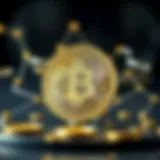In-depth Analysis of NFT Crypto Coins and Their Impact


Intro
The rise of NFT crypto coins has captured the imagination of investors, artists, and tech enthusiasts alike. In a landscape peppered with rapid advancements, it's crucial to grasp the foundational concepts driving these digital assets. NFTs, or non-fungible tokens, represent a distinct leap in how we perceive ownership and value in the digital realm.
Understanding this shift not only invites discussions about art and music but also broadens perspectives on speculative investments and market dynamics. With various classifications and underlying technologies, navigating the world of NFT crypto coins can feel like walking through a maze. However, this article is designed to shed light on these complexities, making it accessible whether you're diving in for the first time or looking to expand your existing knowledge.
By breaking down the nuances of NFT classification, exploring market trends, and addressing pertinent legal considerations, this piece aims to provide comprehensive insights. We will also dissect investment strategies worth exploring in this ever-changing landscape, ensuring that readers are well-equipped to make informed decisions.
It's an exciting time to explore this space, where each opportunity carries the potential for innovation and change. As we embark on this journey, let's ground ourselves in the basics of cryptocurrency, which form the backbone of understanding NFT crypto coins.
Prelims to NFT Crypto Coins
The emergence of NFT crypto coins marks a significant shift in how we perceive ownership, value, and creativity in the digital age. NFTs, or non-fungible tokens, have taken the digital marketplace by storm, offering unique digital assets that are irreproducible. This section will illuminate the importance of NFTs within the broader cryptocurrency landscape and their unique characteristics, which set them apart from more traditional digital currencies.
NFTs have redefined ownership by providing a way to prove authenticity and ownership of digital assets, be it art, music, or even virtual real estate. Unlike Bitcoin or Ether, which are fungible and can be exchanged one-for-one, NFTs possess unique identifiers that make them distinct from one another. This uniqueness is a key pillar that fuels their appeal among collectors and investors alike.
Key Elements to Consider:
- Ownership and Authenticity: NFTs enable digital ownership that can’t be faked.
- Market Expansion: They are broadening the horizons for creators in various fields, allowing them to monetize their work directly.
- Investment Opportunities: Collectors are increasingly viewing NFTs as an investment strategy, shifting their focus from traditional assets to digital collectibles.
In an environment where digital transactions are becoming the norm, understanding NFT crypto coins is paramount to grasping not only their potential financial implications but also their cultural and artistic significance.
Defining NFTs and Their Role in Crypto
To understand NFTs, one must first recognize their definition as a digital asset that represents ownership of a unique item or piece of content on the blockchain. Unlike cryptocurrencies such as Bitcoin or Ethereum, NFTs are not interchangeable. Each token's value is derived from its uniqueness, regardless of the underlying technology.
In simpler terms, if you picture a coin, each coin is the same as another and holds the same value. Now, consider a baseball card: every card has its own specific value based on rarity and condition. This principle applies to NFTs. They are not merely bits of data; they represent the ownership and provenance of digital items. Ultimately, NFTs bridge the gap between the blockchain technology that underpins crypto assets and the tangible satisfaction of owning a piece of digital art or collectible.
Role within Cryptocurrency Market:
- Utility: NFTs are being used in various sectors including gaming, art, and technology, each providing a unique use case.
- Market Growth: They are driving new market dynamics, often leading to rapid increases in investment and speculation.
- Community Building: Enthusiasts and investors come together in niche markets that foster a sense of community and collaboration around shared interests.
The Intersection of NFTs and Cryptocurrency
NFTs represent a pivotal intersection between art and technology, where ownership is authenticated using blockchain. This marriage of creativity and cryptography opens new avenues for artists and entrepreneurs alike, allowing traditional concepts of value to be redefined.
One of the noteworthy aspects of NFTs is their integration with cryptocurrencies. They use the same blockchain technology, allowing for the seamless transaction of assets in a decentralized manner. This enables users to buy and sell NFTs using cryptocurrencies, thereby expanding their applications beyond mere collectibles.
Significance in the Market:
- Innovative Sales Channels: Artists can tap into a global audience without traditional gatekeepers, totally changing how art is perceived and distributed.
- Smart Contracts: These allow for automated royalties every time an NFT is resold, ensuring creators continue to benefit from their work.
- Digital Identity and Ownership: NFTs facilitate personal branding and identities in online spaces, granting users a sense of virtual ownership.
Through these lenses, it’s evident that the relationship between NFTs and cryptocurrency is symbiotic—each enhances and amplifies the other’s strengths and potential for future development. For investors, understanding this interconnectedness is crucial as it provides insights into the evolving nature of value in our increasingly digital world.
"NFTs offer a groundbreaking way for artists and creators to gain recognition and profit from their work without the constraints of traditional markets."
As we proceed through the sections, we will delve deeper into the various classifications and prominent players in the NFT space, illuminating their impact on the market and the potential challenges that lie ahead.
Types of NFT Crypto Coins
Understanding the different types of NFT crypto coins is essential for anyone looking to grasp the complexities and opportunities within the market. Each type serves a unique purpose and can be influential in guiding investment choices. With the rapid evolution of the NFT space, recognizing these distinctions can give investors, tech enthusiasts, and educators a leg up in navigating this innovative frontier.
Governance Tokens
Governance tokens have become a cornerstone of decentralized finance (DeFi) and the NFT space. They empower holders to participate in the decision-making processes of specific platforms or projects. For instance, if you hold a governance token, you might have the right to vote on proposals that affect the platform's direction, features, or funding allocations.
One prominent example of this is Uniswap, whose governance token, UNI, allows holders to propose and vote on changes. This type of engagement fosters a community-driven approach, giving users a voice in the ecosystem. Since governance tokens align with the ethos of decentralization, they can enhance user loyalty and engagement.
Despite their advantages, potential investors need to be aware of the fluctuating values and the risks that accompany governance tokens. Being a part of the decision-making process might sound appealing, but those decisions can lead to significant volatility in token price based on community sentiment.
"Being a part of governance in NFT projects is like being on the board of a startup; you hold power, but the future hinges on a collective agreement."
Utility Tokens


Utility tokens play a crucial role in providing access to a specific service within an NFT platform or ecosystem. Unlike governance tokens that emphasize control, utility tokens focus on the practicality of usage. These tokens act as the currency within their ecosystems, allowing users to pay for transaction fees, access exclusive content, or unlock premium features.
Take Decentraland, for example, which uses MANA as its core utility token. Users can purchase land and engage in various activities within this virtual world using MANA. This direct connection of utility to the NFT experience adds immense value and can spark interest among investors looking for tokens with real-world applications.
Additionally, understanding the utility of a token can provide insights into its long-term value proposition. At the heart of utility tokens lies the interaction between users and the platform. A project that can sustain user engagement fulfills its purpose and can see increased demand for its token. This creates a cycle of growth that benefits both the platform and its users.
Collectible Tokens
Collectible tokens represent one of the most captivating aspects of NFTs. These tokens often take the form of digital art, music, virtual real estate, or even unique in-game assets. Collectible tokens harness the power of uniqueness and scarcity, making them appealing to collectors and investors alike. The allure often stems from the story behind the piece or its creator.
Take CryptoPunks, one of the earliest NFT projects, which features 10,000 unique 24x24 pixel art characters. The rarity and cultural significance of each punk have made them a hot commodity, with some selling for millions of dollars. Collectibles appeal not only to a niche audience but also introduce new investors to the NFT market, driven by fandom and passion.
Nonetheless, the collectibles market is not without challenges. Valuations can be highly subjective, often influenced by trends and the whims of collectors. Investors need to identify not just unique pieces but also those that resonate over time. The nostalgia factor and cultural relevance can play significant roles in determining the lasting value of collectible tokens.
In summary, each type of NFT crypto coin presents its unique characteristics and benefits. Governance tokens empower holders with decision-making abilities, utility tokens facilitate access to services, and collectible tokens offer a way to own unique digital assets. As investors and enthusiasts delve deeper into the NFT landscape, understanding these types provides a comprehensive foundation for informed participation in the ever-evolving market.
Prominent NFT Coins in the Market
The segment focusing on prominent NFT coins holds significant weight in this article. As NFTs continue to proliferate and evolve, understanding the leading coins is crucial for investors, tech enthusiasts, and educators alike. These digital assets pave the way for numerous applications across industries, ushering in new opportunities and challenges. The choice of blockchain platforms running these NFTs directly impacts everything from transaction speed to community engagement. Knowing which NFT coins dominate the landscape informs decision-making for both investment and development.
Ethereum and its Token Standards
Ethereum stands tall as the primary platform for NFTs, largely due to its smart contract functionality and established ecosystem. Two prevalent token standards are ERC-721 and ERC-1155.
- ERC-721: This is the original standard for NFTs, facilitating unique tokens that represent distinct items. Each token has its metadata, making them indivisible and irreplaceable. Think of owning a classic Picasso painting: each piece has a unique value and identity.
- ERC-1155: Contrarily, this standard introduces a more efficient method to manage multiple types of tokens on the same contract. Imagine having a game where you can use both unique swords and common health potions without needing different contracts for each.
Ethereum's extensive reach allows for a myriad of applications, from virtual real estate to digital art. The Ethereum community regularly updates its protocols, enhancing scalability and cost-efficiency.
“With its vast array of tools and community support, Ethereum remains the heartbeat of the NFT market.”
Flow and its Use Cases
Flow, developed by Dapper Labs, presents itself as an alternative specifically designed for NFTs, notably through its spotlight on scalability. This blockchain is built for speed, with the ability to handle thousands of transactions per second. This architectural advantage allows it to support a growing range of applications including gaming and collectibles.
Noteworthy use cases include:
- NBA Top Shot: A platform infamous for its video highlights converted into collectible moments. Users can buy, sell, and trade these highlights in a manner similar to trading cards.
- CryptoKitties: Another Dapper creation, showcasing unique digital cats through a playful yet simplistic interface. This game transformed the way developers could monetize digital creatures, emphasizing user interaction.
Flow’s unique structure creates new avenues for developers to engage users, making it a compelling area for investment consideration.
Binance Smart Chain Tokens
Binance Smart Chain (BSC) has emerged as a formidable contender in the NFT space, mainly due to its low transaction fees and fast processing times. Integrating with the extensive Binance ecosystem allows for quick liquidity and diverse trading options, which is appealing for both creators and buyers.
Some prominent NFT projects on BSC include:
- PancakeSwap NFTs: The decentralized exchange allows users to trade unique digital assets alongside traditional tokens.
- CryptoPunks on BSC: While originally Ethereum-based, these iconic collectibles have made their way to BSC, indicating the cross-chain possibilities inherent in today's market.
The appeal of BSC lies in its community-driven initiatives that create a vibrant environment for NFT innovativeness. As the platform continues to evolve, its impact on the NFT market will be crucial to observe.
Understanding these prominent NFT coins can significantly inform and enhance your investment strategy, adding depth to your insight into the NFT marketplace.
The Technology Behind NFTs
As we navigate through the realm of NFT crypto coins, understanding the technological backbone of this innovation becomes paramount. NFTs, by their very nature, hinge on advanced technology, which serves not only to authenticate digital assets but also to provide a robust framework for these transactions. The underlying mechanisms hold the key to their value, security, and utility in the crypto space.
Blockchain Fundamentals
At the heart of NFTs lies blockchain technology. This decentralized ledger system is the reason NFTs can operate without the need for intermediaries. Essentially, a blockchain is a series of blocks that store data information in a secure and transparent manner. When an NFT is created, a unique record is inscribed onto the blockchain, marking its authenticity and ownership.
An important feature of blockchains is that they are immutable. This means once a block is added, it cannot be altered or deleted without consensus from the network, making this technology particularly appealing for assets that require trust and transparency. Furthermore, since all transactions are recorded publicly, anyone can verify the ownership history of an NFT, adding a layer of legitimacy that is crucial for investors.
"The importance of blockchain technology in the realm of NFTs cannot be overstated. It forms the basic structure for ownership and provenance, making it vital for creators and collectors alike."
Smart Contracts and Their Functions


Smart contracts are another essential element in the operation of NFTs. Think of them as self-executing contracts with the agreement directly written into code. They automatically execute actions when certain conditions are met, thus facilitating trustless transactions between parties. For instance, when an NFT is sold, a smart contract can automatically transfer the NFT to the buyer's wallet and the cryptocurrency payment to the seller's wallet simultaneously.
This automation not only enhances efficiency but also cuts down on potential disputes. They minimize the need for manual intervention, reducing costs and errors in the transaction process. In addition, smart contracts can also incorporate royalties, allowing creators to earn a percentage of subsequent sales, which is an innovative way to support artists and creators over time.
Interoperability among NFT Platforms
Interoperability is crucial in the NFT ecosystem. This refers to the ability of different blockchain platforms to communicate and work together. As more NFT marketplaces sprout up, ensuring that these different platforms can integrate with one another allows users to seamlessly buy, sell, and trade NFTs across various networks.
For example, an NFT created on Ethereum has the potential to be used within games or platforms that operate on different blockchains, provided there’s proper interoperability. This allows for a wider reach and increases the potential value of the NFTs since they aren't restricted to a single marketplace. Furthermore, interoperability can foster innovation, as creators explore entirely new ways their NFTs can be utilized across divergent platforms.
Market Trends and Indicators
Understanding the market trends and indicators is crucial in the investment landscape for NFT crypto coins. These factors not only provide valuable insights into the current and future states of the NFT market but also guide investors in making informed decisions. By keeping a close eye on these trends, investors can gauge market sentiment, anticipate movements, and better position themselves in a rapidly evolving digital economy.
In particular, market trends can highlight fluctuations in purchasing power, changes in consumer behavior, and emerging technologies that may redefine how NFTs are bought, sold, and perceived. On the other hand, having knowledge of available indicators allows for a quantitative assessment—much like checking the pulse of an economy. Together, these elements create a roadmap for navigating the often unpredictable NFT landscape.
Current NFT Market Dynamics
The current NFT market is characterized by a number of complex dynamics that interplay with traditional investment principles. While 2021 was a historic year for NFTs, witnessing unprecedented sales and interest, 2022 brought a more mature yet cautious approach to investing in digital assets.
Some factors driving the market dynamics include:
- Supply and Demand: As digital creators and brands continue to produce NFTs, the market experiences a tidal wave of supply. Conversely, the demand fluctuates based on market sentiment and investment speculation.
- Diverse Use Cases: NFT applications range from gaming and digital art to real estate and identity verification. This breadth of use cases adds layers to market dynamics, attracting various investor profiles.
- Institutional Interest: Organizations like Visa and Mastercard dipping their toes into the NFT waters signal a shift towards institutional acceptance, which affects market valuations and investor confidence.
This observant balance between supply and demand unveils the diverse forces at play. As the market evolves, it’s imperative to remain vigilant about these dynamics. Knowing when to enter or exit can make all the difference.
Impact of Social Media on NFT Valuations
Social media has transformed how we consume content, and when it comes to NFTs, it functions as both a catalyst and a barometer. Platforms like Twitter, Instagram, and TikTok are increasingly shaping the valuations of NFTs.
The influence of social media manifests through:
- Viral Trends: A single tweet or post can propel an NFT's value from an obscure price point to astronomical heights almost overnight. Sensational trends often spark speculative buying, leading to rapid price hikes.
- Community Engagement: Many NFT projects thrive on their communities. Active discussions, collaborations, and fan engagement can boost an asset's perceived value. If a project has a tight-knit community backing it, its valuation is likely to hold stronger.
- Influencer Endorsements: The power of social media influencers cannot be understated. When a notable figure endorses an NFT, it can create a buzz that translates directly into valuation spikes.
"In the digital age, content is king, but engagement is the kingdom."
The relationship between social media and NFT valuations illustrates the importance of market sentiment and communication. Understanding this factor could mean the difference between a wise investment and a financial faux pas. As the digital landscape evolves, social media remains a potent force shaping both perceptions and prices in the NFT realm.
By understanding and analyzing these market trends and indicators, investors, educators, and tech enthusiasts alike can navigate the complexities of the NFT landscape more effectively, ensuring they are well-prepared to seize opportunities and mitigate risks as they arise.
Investment Strategies for NFTs
In the rapidly evolving ecosystem of NFT crypto coins, carving out effective investment strategies is more crucial than ever. The unique nature of NFTs, being not just mere tokens but representations of ownership of digital assets, adds an extra layer of complexity for investors. These strategies can have a significant impact on securing long-term gains while navigating potential risks. As the NFT landscape becomes increasingly crowded and competitive, understanding how to approach investing in NFTs can mean the difference between success and stagnation.
Assessing NFT Value
Determining the value of an NFT isn't as straightforward as looking at its price tag. Unlike traditional assets, NFTs carry intrinsic qualities shaped by their uniqueness, artwork, creator reputation, and even the community surrounding them.
- Rarity: An NFT's rarity is usually what drives its market worth. For instance, a limited edition piece from a well-known artist can fetch astronomical prices simply due to how few exist.
- Provenance: The history behind an NFT—the story of who created it and past owners—can heavily influence its value. Authenticity is paramount.
- Market Trends: Tracking trends can be pivotal. Are there noticeable patterns in buyer behavior during certain seasons or events? Understanding when to buy and sell can provide a statistical advantage.
- Utility: Some NFTs offer additional benefits, like access to exclusive content or communities. Knowing their added value can elevate the overall worth.
While these factors offer a lens through which to assess an NFT's value, connecting with the right community can yield the insights needed to make more informed decisions.
Long-term vs Short-term Investment Approaches
When it comes to NFTs, the path you choose—be it long-term or short-term—will drastically influence your strategy. Each approach carries its set of considerations and potential pitfalls.
- Short-term Investments: These are akin to day trading, where investors buy a piece to flip it for quick profits. The advantage here is the potential for rapid gains. However, the risk lurks in volatility; the market can swing wildly, and without diligent research, investors might end up holding the bag.
- Long-term Investments: Adopting a long-term view means purchasing NFTs with the belief that they will appreciate over time. This strategy often aligns with poorer nerves as it's not about immediate returns but rather trusting in the art and community behind the NFT. It requires patience, research, and sometimes, a strong emotional connection with the asset.
Both strategies necessitate a keen eye for research and trend analysis while emphasizing that the NFT landscape is anything but static. Investors should be flexible and willing to adapt as new players and technology emerge. Ultimately, striking the right balance between these approaches can enhance overall portfolio performance, aiding in navigating this vibrant yet unpredictable market.
Remember: NFT investing is akin to navigating unchartered waters; being prepared can be your compass.
Whether you choose to explore short-term flip strategies or the steady growth of long-term holds, maintaining diligence and open-mindedness will serve you well in the NFT arena.


Legal and Regulatory Considerations
Understanding the legal landscape surrounding NFT crypto coins is essential for all participants, be they creators, investors, or enthusiasts. In today’s digital age, where ownership can often be as abstract as a byte, having a grasp on legal and regulatory aspects can be the difference between safe transactions and costly missteps. The intersection of copyright, taxation, and consumer rights makes this a crucial area of focus.
Being aware of these regulations not only protects individuals but also shapes the trajectory of the whole NFT market. Without clear guidelines, the risk of fraud and misrepresentation remains high. Furthermore, investors should stay well-informed to avoid legal entanglements that could affect the perceived value of their assets.
Intellectual Property Issues
Intellectual property (IP) laws play a pivotal role in the NFT ecosystem. When someone creates an NFT, what they are typically selling is a digital certificate of ownership rather than the copyright itself. This creates a peculiar situation; the creator might retain rights to the original work unless explicitly transferred. A comprehemsive understanding of this can save you from future disputes over ownership or usage rights.
For example, a digital artist can mint an NFT of their artwork, but unless they legally transfer the copyright, they can still control how that work is used. Issues may arise when the NFT changes hands. If a buyer assumes they have purchased full rights but only received a certificate, that could lead to disagreements and potential legal action.
"It's not just about owning a digital asset; it's about understanding what ownership means in a world where digital and physical are increasingly intertwined."
Consider these aspects while dealing with NFTs:
- Copyright Ownership vs. Ownership of NFT: Knowing the difference is key.
- Transferability: Can rights be transferred with the NFT?
- Infringement Risks: As an investor, be cautious of what you’re investing in. Ensure the seller has legitimate rights to the work.
Tax Implications of NFT Trading
Tax implications in NFT trading can be as murky as the assets themselves. Many countries are still formulating policies on how to treat cryptocurrency and digital assets. For investors, understanding tax liabilities is crucial to avoiding potential penalties.
Generally, trading NFTs can trigger capital gains taxes, which means profits made from selling an NFT may be taxable. This can become particularly complex due to the volatile nature of NFT prices. Additionally, if you trade NFTs for other cryptocurrencies or even fiat currency, you may also have to account for those transactions in your tax filings.
Key points to keep in mind include:
- Record Keeping: Maintain a detailed record of your purchase prices, sale prices, and dates to accurately report gains or losses.
- Regulatory Variations: Understand the tax rules in your jurisdiction as they can vary significantly from one place to another. Legal resources are available through governmental sites like IRS or consult with a tax professional.
- Reporting Obligations: Ensure you comply with reporting requirements, including any potential tax on gifts if you transfer an NFT without receiving consideration.
Navigating legal and regulatory considerations can be confusing, yet it's vital for ensuring a secure and informed approach to engaging with NFT crypto coins.
The Future of NFT Crypto Coins
The landscape of NFT crypto coins is poised for a transformation that could redefine how we perceive ownership and value in the digital world. As technology advances and society continues to embrace decentralized cryptocurrencies, the future of NFTs reflects a blend of innovation and opportunity. Understanding the potential trajectory of these digital assets is crucial for investors, tech enthusiasts, and educators alike.
Emerging Trends to Watch
In the rapidly evolving world of NFTs, several trends are beginning to take shape that could signal significant shifts in the market:
- Integration with Real-World Assets: As NFTs gain traction, there’s a movement towards tokenizing physical assets, like real estate or art. This integration could simplify transactions and democratize access to high-value investments, offering even non-wealthy individuals a chance to invest.
- Dynamic NFTs: Unlike static tokens, dynamic NFTs can change based on external factors like time or user interaction. This concept opens doors for more interactive and engaging digital experiences, especially in gaming and digital storytelling.
- Environmental Sustainability: With environmental concerns in mind, platforms are exploring ways to create eco-friendly NFTs that consume less energy. This trend may involve the adoption of more energy-efficient consensus mechanisms, appealing to the growing demographic of environmentally-conscious investors.
"The shift towards sustainable practices in the NFT space may determine its long-term viability and societal acceptance."
- Interoperability Solutions: As multiple NFT platforms develop, efforts to enable interoperability will be essential. This development allows NFTs to move seamlessly across various platforms, increasing their utility and marketability.
- Enhanced Utility in DeFi: The crossover of NFTs with decentralized finance (DeFi) could pave the way for new financial products and services. Imagine using NFTs as collateral for loans or providing access to exclusive DeFi projects.
These trends underscore the dynamism within the NFT sector, suggesting a path towards a more integrated, user-focused approach in the years to come.
Potential Challenges Ahead
While the future of NFT crypto coins looks promising, there are several challenges that could impact their development and adoption:
- Legal and Regulatory Issues: The legal landscape around NFTs is still quite murky. Questions about ownership rights, copyright infringement, and regulatory frameworks may wobble the innovative nature of NFTs, potentially hindering adoption.
- Market Volatility: The NFT market has shown significant price swings, leading to uncertainty among potential investors. As interest rates rise or economic conditions change, speculative bubbles could burst, leaving many with depreciated assets.
- Security Concerns: With the rise of digital assets comes the increase in hacking and theft incidents. Users must ensure their NFTs are stored securely, which could require ongoing education about best practices in digital security.
- Saturation of the Market: As more creators jump into the NFT space, there’s a risk of oversaturation. Too many offerings could dilute the perceived value, making it difficult for individual projects to stand out.
- Environmental Backlash: The energy consumption associated with certain blockchain networks continues to face criticism. If the industry doesn’t take significant steps to address sustainability, it may encounter backlash from both consumers and regulators.
The future holds a mix of possibilities and pitfalls for NFT crypto coins. As the landscape evolves, it is essential to stay informed about these trends and challenges to make well-informed decisions in this dynamic marketplace.
Epilogue
The conclusion serves as the cornerstone of any comprehensive examination of NFT crypto coins, encapsulating the multifaceted elements discussed throughout the article. In the realm of digital assets, NFTs have grown from a niche concept to a significant player in the larger cryptocurrency landscape. Understanding this journey is crucial for investors, tech enthusiasts, and educators alike, as it offers a window into the evolution of ownership and value perception in the digital age.
Summarizing Key Insights
As we wrap up, several key insights emerge:
- Diverse Utility: NFT crypto coins encompass a wide range of categories, from governance tokens, which facilitate decentralized decision-making, to collectible tokens that appeal to the art market and beyond. Each type serves a distinct purpose and shows the versatility of NFTs in various sectors.
- Underpinning Technology: The blockchain technology at the heart of NFTs is a testament to transparency and security. Every transaction is recorded immutably, fostering trust among participants while minimizing fraud.
- Market Dynamics: The NFT market is deeply intertwined with social media, impacting valuations and demand. As trends ebb and flow, the importance of understanding these market dynamics becomes glaringly evident.
- Investment Strategies: For those looking to dip their toes in the NFT waters, recognizing the difference in investment approaches is vital. Long-term holds versus quick sales can dictate success based on market stability or volatility.
- Legal Landscape: Legal and regulatory considerations cannot be underscored enough. Issues like intellectual property rights and tax implications shape the way NFTs are traded and perceived by users and investors alike.
Encouraging Informed Participation
For anyone considering involvement in the NFT space, informed participation cannot be stressed enough. Here are some considerations to keep in mind:
- Research, Research, Research: Prior to making any investments or trades, it’s essential to stay updated with reliable information from sources like Wikipedia, Britannica, or even community engagement on platforms like Reddit.
- Evaluate Projects Thoroughly: Not every NFT or platform will succeed. A critical eye for assessing the viability and potential longevity of projects can save one from pitfalls.
- Follow Legal Developments: As laws continue to evolve, especially surrounding digital assets, keeping abreast of these changes via credible resources such as government sites or reputable news outlets is necessary.
- Engagement with Community: Being active in the NFT community, whether through forums, social media groups, or local meet-ups, can provide insights and opportunities that aren’t readily apparent through traditional channels.
NFT crypto coins are not merely a fleeting trend; they represent a shift in how we perceive value in the digital realm. Embracing this paradigm shift with diligence and knowledge can pave the way for meaningful engagement and investment opportunities. The knowledge shared in this article serves as a foundational stepping stone towards understanding and navigating this innovative landscape.







